|
|
 |
|
Calanoida ( Order ) |
|
|
|
Clausocalanoidea ( Superfamily ) |
|
|
|
Euchaetidae ( Family ) |
|
|
|
Paraeuchaeta ( Genus ) |
|
|
| |
Paraeuchaeta mexicana Park, 1995 (F) | |
| | | | | | | Syn.: | Euchaeta aequatorialis : Park, 1975 c (p.8, figs.F); ? Vervoort, 1963 b (p.172, figs.F,M) | | | | Ref.: | | | Park, 1994 (p.319); 1995 (p.44, Descr.F, figs.F, Rem;: p.45) | 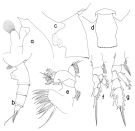 issued from : T. Park in Bull. Scripps Inst. Oceanogr. Univ. California, San Diego, 1995, 29. [p.143, Fig.33]. Female: a, forehead (left side); b, urosome (left); c, d, genital somite (left, dorsal, respectively); e, Mx1 (first inner lobe separated), posterior; f, P1 (anterior); P2 (anterior). Nota: Similar in habitus to P. magaloba and P. aequatorialis but distinguishable from them by the following charateristics: Laterally, rostrum nearly triangular with wide base, straight anterior margin, and slightly curved posterior margin. Supralabrum relatively large. Genital somite relatively short, its dorsal wall with a low hump at middle. Ventral margin of genital flange somewhat concave and roughtly parallel to long axis somite. Posterior edge of genital field produced into a relatively large lobe. Anterior margin of genital prominence bulging; posterior margin about 2/3 length of posterior ventral wall of somite and they meet in a sharp curve. Dorsally, genital somite symmetrical. Cephalosomal appendages similar to those of P. magaloba except that outer lobe of Mx1 with 7 long setae plus a minute seta proximally.
|
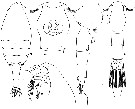 issued from : W. Vervoort in Atlantide Report., 1963, 7. [p.172, Fig.18]. As Euchaeta aequatorialis. See in Remarks. Female (from Angola-Sierra-Leone): a, habitus (dorsal); b-c, posterior part cephalothoras and urosome (dorsal view and lateral view from right side, respectively); d, genital somite (ventral); e, forehead (lateral). (a: x20; b, c, e: x44; d: x88).
|
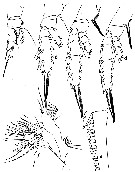 issued from : W. Vervoort in Atlantide Report., 1963, 7. [p.173, Fig.19]. As Euchaeta aequatorialisFemale: a-d, P1 to P4; e, part of the row of teeth along apical spine of exopodite P4; f, Mx1. (a-d: x55; e: x240; f: x125).
|
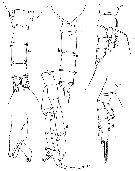 issued from : W. Vervoort in Atlantide Report., 1963, 7. [p.174, Fig.20]. As Euchaeta aequatorialis. Male (from Angola-Sierra-Leone): a-b, posterior part cephalothorax and urosome (dorsal and lateral view from right side); c, P1; d, P2; e, P5; f, extremity of exopodite of left P; (a, b; d, e: x55; c: x88; f: x135).
|
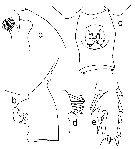 issued from : T. Park in Smiths. Contr. Zool., 1975, 196. [p.9, Fig.6]. As Euchaeta aequatorialis. Female (G. of Mexico): a, forehead (lateral); b-c, genital segment (lateral and ventral, respectively); d, outer lobe of Mx1; e, exopod of P2 (anterior). Nota: 3.04-3.24 mm in prosome length.
|
 Paraeuchaeta mexicana Paraeuchaeta mexicana Female: 1 - See key to species Groups and independent species of Paraeuchaeta (p.30): malayensis species Group. 2 - Outer spine of 2nd exopodal segment (or the 2nd of the first 2 exopodal segments forming a proximal, compound segment) of P1 normally developed (Fig.33-f). 3 - Outer lobe of Mx1 with 7 long setae in addition to 1 or 2 minute setae proximally (Fig.33-e). 4 - Genital somite without a conical process on left side close to anterior base of genital prominence (Fig.33-c). 5 - Dorsally and ventrally, genital somite symmetrical (Fig.33-d). 6 - Laterally, genital flange with normal posterior lobe (Fig.33-c). 7 - Laterally, genital somite with more or less smooth dorsal margin (Fig.33-c). 8 - Laterally, genital prominence with nearly straight or only slightly bulging posterior margin (Fig.33-c). 9 - Outer lobe of Mx1 with 7 long setae plus 1 or 2 very minute setae (Fig.33-e). 10 - Laterally, genital prominence with posterior margin equal to or shorter than half length of posterior ventral wall of somite (Fig.33-c). 11 - Laterally, posterior edge of genital field similar in shape and size to posterior lobe of genital flange (Fig.33-c).
| | | | | Compl. Ref.: | | | Suarez-Morales & Gasca, 1998 a (p.109) (? non the localisation E Pacif.) | | | | NZ: | 2 + 1 doubtful | | |
|
Distribution map of Paraeuchaeta mexicana by geographical zones
|
| | | | Loc: | | | G. of Mexico, ? G. of Guinea (in Vervoort, 1963 b), NE Pacif. (Hernandez-Trujillo & Esqueda-Escarcega, 2002).
Locality type: 23°45'N, 91°30'W. | | | | N: | 2 | | | | Lg.: | | | (19) F: 4,24-4,16; {F: 4,16-4,24} | | | | Rem.: | The discrimination between this species and P. aequatorialis needs a profound review, in particular of the external lobe of MX1.
Hernandez-Trujillo & Esqueda-Escarcega, 2002 (in Appendix) do not confirm this species in the G. of Mexico, but in West Mexico (Eastern Pacific).
After Park (1995, p.45), this species resembles in habitus to P. magaloba and P. aequatorialis. Vervoort (1963) described E aequatorialis from the Gulf of Guinea, but his form seems to belong to this new species. It differs from the original description of P. aequatorialis in the form of the serrated lamella of the left P5 exopod, which in verwoort's specimens is relatively broad at the distal end rather than tapering in a point as described by Tanaka (1958). The male of P. aequatorialis found by Park is in full agreement with Tanaka's description. Yhree female specimens have been prviously reported by Park (1975) as P. aequatorialis Tanaka, 1958. After reexamination, they were found to be obviously different from P. aequatorialis Tanaka in the following features: The rostrum is much thicker; the dorsal hump of the genital somite is less pronounced; the genital flange is emarginate; the outer lobe of Mx1 has 7 long setae (instead of 5); in the P1 exopod, the 2nd and 3rd outer spines are relatively long; in the P2 exopod, the 2nd and 4th outer spines are of equal length. | | | Last update : 27/01/2015 | |
|
|
 Any use of this site for a publication will be mentioned with the following reference : Any use of this site for a publication will be mentioned with the following reference :
Razouls C., Desreumaux N., Kouwenberg J. and de Bovée F., 2005-2025. - Biodiversity of Marine Planktonic Copepods (morphology, geographical distribution and biological data). Sorbonne University, CNRS. Available at http://copepodes.obs-banyuls.fr/en [Accessed November 30, 2025] © copyright 2005-2025 Sorbonne University, CNRS
|
|
 |
 |








